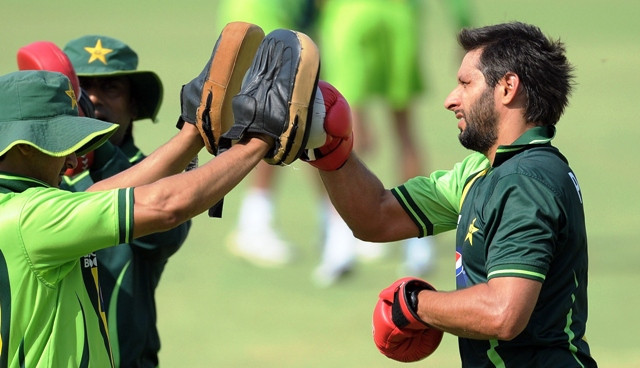I am not a pundit, and I am definitely not Paul the octopus. I am just a cricket fan who believes in his team.
All I ask of other cricket followers is to show respect to our highly talented cricketers who have played exceptionally well to qualify for the semi-final.
There is every chance that Pakistan will end up playing at the Wankhede Stadium on April 2, 2011. Us Pakistani “rickshaws” will take the highway to Mumbai, leaving behind the BMWs Mr Shastri has claimed India to be.
Team Pakistan can win the semi-final, and nonsensical warnings from Mr Rehman Malik will not hurt our chances.
A trip down memory lane
In 1992, Team Pakistan won five consecutive matches to clinch the World Cup. Luck may have been on our side, but to say that the whole World Cup win had nothing to with the talent of the Pakistani players is just a denial of facts.
Inzi played a gem of an innings in the semi-final and Wasim Akram produced those two deadly deliveries in the final.
In 1983, India was beaten by Australia with a margin of 162 runs in the group stages. Should I say that a team bowled out for 158 against the Australians, who were beaten by minnows Zimbabwe in their first game, went on to win the World Cup just because God was on their side? No - India played well and came out as deserving winners.
It is best if we accord the same respect to Team Pakistan for the 1992 triumph.
We don’t lack the basics
Sehwag, Sachin and Yuvraj are amongst the top run-getters of this tournament. But should this analysis be done without taking a look at the conditions under which those matches were played?
Here is a fact: India played all its matches in India, barring the opening match against Bangladesh. Pitches in India are much more conducive to batting than the ones in Sri Lanka, where Pakistan played most of its matches.
The pitches in Sri Lanka not only offer help to seam bowlers upfront but run-scoring is also difficult on those pitches. The average total during a domestic competition on the newly-laid pitches at the R Premedasa Stadium in Colombo was 225. Team Pakistan bettered it by 52 runs, scoring 277 against the mighty Sri Lankans.
Dhoni and Raina may be in “immaculate form” but Raina has only played two games, scoring a total of 38 runs in the tournament while Dhoni has a paltry 125 runs from six innings in the World Cup.
Pakistan’s bowling attack has been called “average” by cynics. In my opinion, no other’s team attack is more potent: Shahid Afridi is backed by Umar Gul, Wahab Riaz, Saeed Ajmal and Mohammad Hafeez- and you have Shoaib Akhtar waiting in the wings.
With this bowling attack, we managed to bowl out the Windies for 112 on a harmless batting track.
What is required?
Without a doubt, the pressure will be immense and the winner will be the team that absorbs the pressure better.
This match will be a test of every player’s grit and temperament; it will be less a question of mathematics and more a mind game. Each team has won three out of the last six ODIs played between the two teams, starting from the Kitply Cup in Bangladesh (June 2008).
The last time Pakistan played India at Mohali (November 2007), the men in green chased down a stiff target of 322. This will surely be an inspiration for Afridi and his men, given that seniors such as Akhtar, Younis, Misbah and himself saw Pakistan through in that encounter.
India, watch out
During the semi-final tomorrow, cricket euphoria will peak; battle lines will be drawn and strategies chalked out.
The hands of countless cricket fans on both sides of the border will be raised in prayer, asking for nothing but victory. Do we need the Almighty’s help to beat India? The answer is yes, we always need His help.
Does that mean nothing else can save us? No - Team Pakistan possesses the strength and skill to beat India in India.
Reality check: Pakistan can beat India on their home turf
Team Pakistan can win the semi-final, and nonsensical warnings from Rehman Malik will not hurt our chances.



COMMENTS
Comments are moderated and generally will be posted if they are on-topic and not abusive.
For more information, please see our Comments FAQ